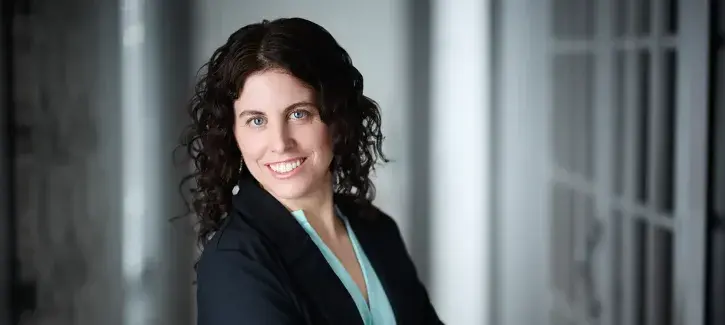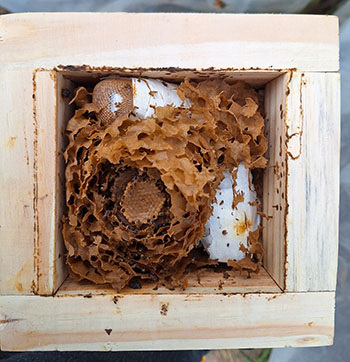
AI ‘listens’ to bees to detect pesticides

When most people think of artificial intelligence, they might picture self-driving cars or chatbots. For Carol Fassbinder-Orth, PhD, professor of biology in Creighton University’s College of Arts and Sciences, AI is helping monitor bee health by analyzing the sounds bees make.
In a recently published, peer-reviewed study, Fassbinder-Orth and collaborators, including Creighton alumnus Chandler Fong, BS’23, and researchers from Brazil, show how machine learning can detect pesticide exposure in stingless bees through sound alone.
“Bees, and really all animals, generate sounds and vibrations with their movements, respiration and communication,” Fassbinder-Orth explained. “Those vibroacoustics can serve as a diagnostic biometric, like a voice or fingerprint, offering a window into health without disturbing the colony.”
From an Iowa farm to global collaboration

The inspiration for this groundbreaking work began close to home, on Fassbinder-Orth’s own Iowa farm. During the pandemic shutdowns, she and her daughter, Amara, then in high school, set up microphones in their hives. Together they tested an early version of the model as a science fair project.
Since then, Fassbinder-Orth has expanded her research to hives in the United States, New Zealand, Tahiti and Chile. At a global honey bee conference in Chile in 2024, she met Brazilian scientist Alex Otesbelgue, who was studying stingless bees. Their collaboration became an opportunity to test the model on species that are not only critical pollinators, but also highly sensitive to pesticides.
“Brazil harbors an extraordinary diversity of stingless bees, which pollinate up to 90% of native flora and hold deep cultural significance,” Otesbelgue noted. “But they are exceptionally vulnerable to pesticides, far more so than honey bees. That makes this research especially urgent.”
How the AI works
The team used Hidden Markov Models (HMMs), a mathematical framework within machine learning, to analyze hive recordings. By converting sound waves into mathematical patterns, the model could correctly identify individual colonies and detect when bees had been exposed to chlorpyrifos, even at sublethal levels.
“It was exciting to see that sound could reveal both colony identity and pesticide exposure,” Fassbinder-Orth said. “Bees sound different depending on their queen and relatedness, and they also sound different when exposed to pesticides, even when outward symptoms are temporary.”
Undergraduates at the center of discovery
For Fassbinder-Orth, involving students in research is just as important as the findings. Fong, who majored in biology at Creighton, played a critical role in setting up and training the machine learning model as an undergraduate.
“Chandler brought a unique combination of computer science skills and biological expertise,” Fassbinder-Orth said. “He helped us figure out the model as we went, and those problem-solving skills are invaluable.”
She points to Creighton’s Center for Undergraduate Research and Scholarship (CURAS) as a reason opportunities like this are possible.
“My time in Washington, DC, as a National Science Foundation program director showed me how rare Creighton’s commitment is,” she said. “The support for undergraduate research here is very strong and unique, especially for a university of our size. Creighton invests heavily in students’ journeys, both in the classroom and in scholarly endeavors, and that dedication is deeply connected to our Jesuit mission.”
This student-centered approach reflects the broader experience of studying biology at Creighton.
What’s next
Whether graduates pursue professional school, research or careers outside of science, Fassbinder-Orth sees these projects as transformative for students. “Research is all about problem solving and critical thinking,” she said. “Those skills translate to any career path, making research experiences valuable for all students.”
Looking ahead, Fassbinder-Orth is partnering with Creighton computer science professor Steven Fernandes, PhD, to build even more advanced neural network models. Their goal? Use sound and other biometrics to predict colony health and disease outcomes, ultimately improving honey bee health worldwide.
“Every step we take in understanding bees helps us protect these vital pollinators,” Fassbinder-Orth said. “And every step we take with students ensures they’re prepared to make an impact in whatever field they choose.”
Read the full study: PLOS One publication
Why study biology at Creighton?
At Creighton, biology students don’t just study living systems, they investigate them firsthand. In small classes led by passionate faculty like Fassbinder-Orth, students are immersed in research opportunities from their very first year, exploring everything from molecular biology to global environmental challenges. Whether preparing for medical or dental school, graduate research, or careers in biotechnology, students learn in a collaborative community shaped by Jesuit values.




